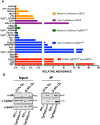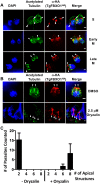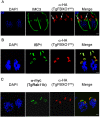Toxoplasma F-box protein 1 is required for daughter cell scaffold function during parasite replication
- PMID: 31348812
- PMCID: PMC6685633
- DOI: 10.1371/journal.ppat.1007946
Toxoplasma F-box protein 1 is required for daughter cell scaffold function during parasite replication
Abstract
By binding to the adaptor protein SKP1 and serving as substrate receptors for the SKP1 Cullin, F-box E3 ubiquitin ligase complex, F-box proteins regulate critical cellular processes including cell cycle progression and membrane trafficking. While F-box proteins are conserved throughout eukaryotes and are well studied in yeast, plants, and animals, studies in parasitic protozoa are lagging. We have identified eighteen putative F-box proteins in the Toxoplasma genome of which four have predicted homologs in Plasmodium. Two of the conserved F-box proteins were demonstrated to be important for Toxoplasma fitness and here we focus on an F-box protein, named TgFBXO1, because it is the most highly expressed by replicative tachyzoites and was also identified in an interactome screen as a Toxoplasma SKP1 binding protein. TgFBXO1 interacts with Toxoplasma SKP1 confirming it as a bona fide F-box protein. In interphase parasites, TgFBXO1 is a component of the Inner Membrane Complex (IMC), which is an organelle that underlies the plasma membrane. Early during replication, TgFBXO1 localizes to the developing daughter cell scaffold, which is the site where the daughter cell IMC and microtubules form and extend from. TgFBXO1 localization to the daughter cell scaffold required centrosome duplication but before kinetochore separation was completed. Daughter cell scaffold localization required TgFBXO1 N-myristoylation and was dependent on the small molecular weight GTPase, TgRab11b. Finally, we demonstrate that TgFBXO1 is required for parasite growth due to its function as a daughter cell scaffold effector. TgFBXO1 is the first F-box protein to be studied in apicomplexan parasites and represents the first protein demonstrated to be important for daughter cell scaffold function.
Conflict of interest statement
The authors have declared that no competing interests exist.
Figures








Similar articles
-
The Toxoplasma gondii F-Box Protein L2 Functions as a Repressor of Stage Specific Gene Expression.PLoS Pathog. 2024 May 30;20(5):e1012269. doi: 10.1371/journal.ppat.1012269. eCollection 2024 May. PLoS Pathog. 2024. PMID: 38814984 Free PMC article.
-
Identification and Molecular Dissection of IMC32, a Conserved Toxoplasma Inner Membrane Complex Protein That Is Essential for Parasite Replication.mBio. 2021 Feb 16;12(1):e03622-20. doi: 10.1128/mBio.03622-20. mBio. 2021. PMID: 33593973 Free PMC article.
-
Loss of the Conserved Alveolate Kinase MAPK2 Decouples Toxoplasma Cell Growth from Cell Division.mBio. 2020 Nov 10;11(6):e02517-20. doi: 10.1128/mBio.02517-20. mBio. 2020. PMID: 33173004 Free PMC article.
-
Genetically engineered mouse models for functional studies of SKP1-CUL1-F-box-protein (SCF) E3 ubiquitin ligases.Cell Res. 2013 May;23(5):599-619. doi: 10.1038/cr.2013.44. Epub 2013 Mar 26. Cell Res. 2013. PMID: 23528706 Free PMC article. Review.
-
Organelle Dynamics in Apicomplexan Parasites.mBio. 2021 Aug 31;12(4):e0140921. doi: 10.1128/mBio.01409-21. Epub 2021 Aug 24. mBio. 2021. PMID: 34425697 Free PMC article. Review.
Cited by
-
BCC0 collaborates with IMC32 and IMC43 to form the Toxoplasma gondii essential daughter bud assembly complex.PLoS Pathog. 2024 Jul 18;20(7):e1012411. doi: 10.1371/journal.ppat.1012411. eCollection 2024 Jul. PLoS Pathog. 2024. PMID: 39024411 Free PMC article.
-
Identification of IMC43, a novel IMC protein that collaborates with IMC32 to form an essential daughter bud assembly complex in Toxoplasma gondii.PLoS Pathog. 2023 Oct 2;19(10):e1011707. doi: 10.1371/journal.ppat.1011707. eCollection 2023 Oct. PLoS Pathog. 2023. PMID: 37782662 Free PMC article.
-
Toxoplasma ERK7 protects the apical complex from premature degradation.J Cell Biol. 2023 Jun 5;222(6):e202209098. doi: 10.1083/jcb.202209098. Epub 2023 Apr 7. J Cell Biol. 2023. PMID: 37027006 Free PMC article.
-
Profiling of myristoylation in Toxoplasma gondii reveals an N-myristoylated protein important for host cell penetration.Elife. 2020 Jul 3;9:e57861. doi: 10.7554/eLife.57861. Elife. 2020. PMID: 32618271 Free PMC article.
-
The Skp1-Cullin1-FBXO1 complex is a pleiotropic regulator required for the formation of gametes and motile forms in Plasmodium berghei.Nat Commun. 2023 Mar 10;14(1):1312. doi: 10.1038/s41467-023-36999-8. Nat Commun. 2023. PMID: 36898988 Free PMC article.
References
-
- Dubey JP. History of the discovery of the life cycle of Toxoplasma gondii. Int J Parasitol. 2009;39(8):877–82. Epub 2009/07/25. . - PubMed
Publication types
MeSH terms
Substances
Grants and funding
LinkOut - more resources
Full Text Sources
Molecular Biology Databases
Research Materials

